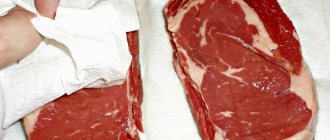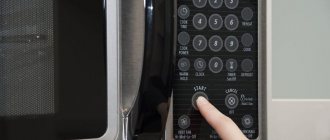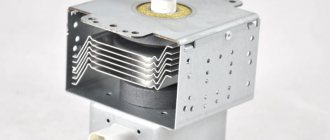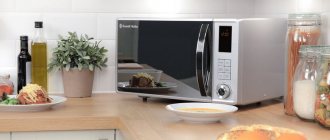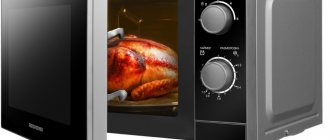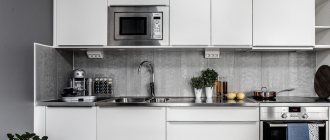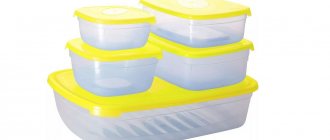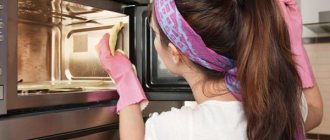Microwave ovens appeared in Russia several decades ago and have long been included in the standard set of equipment in almost every kitchen. And yet, it is precisely this device that is associated with the largest number of stories - not only funny, but also sad - from the category “What should not have been done.”
What dishes should not be used in the microwave?
What dishes are suitable for the microwave?
How to check if the cookware is suitable?
What foods should not be heated in the microwave?
These products require caution
Can a microwave be used for sterilization?
Is it possible to steam seedling soil in the microwave?
Theoretically, everyone has the idea that a microwave oven is not suitable for every product (or not every product is suitable for it), that there are restrictions on the material and properties of microwave cookware, and most importantly, that a microwave oven is intended exclusively for cooking and gives much less scope for unexpected ideas than a conventional stove or oven. What is typical is that manufacturers do not hide all this and supply each instruction manual for their device with a solid list of various “don’ts” and “not recommended.” But alas, our people rarely read instructions, no matter how much they convince him of their importance and frighten him with the consequences. As a result, of all household equipment, it is the microwave oven that still remains the “generator of surprises” that might not have happened.
Read the instructions before using the microwave
What dishes should not be used in the microwave?
You should absolutely not use metal utensils as they reflect microwaves. This category also includes containers with metal parts, rims and patterns, applied with shiny paint (which may contain metal particles), coated with cobalt blue. Naturally, you should not place any other metal objects in the microwave oven - cutlery, barbecue skewers, frying needles, food packaging parts, etc. It is not recommended to place dishes made of glazed glass and painted earthenware in the microwave, since the glaze and dish paints may also contain metals.
Wooden utensils are also prohibited. When heated, moisture evaporates from the wood, and the container may simply crack right in the oven or in your hands when you take it out. The consequences of both are quite imaginable.
Crystal and thin glass should not be placed in the oven. Most crystal products contain some amount of lead, so there is a high chance that the glassware will simply crack. Thin glass can crack simply from overheating. Pay attention to the accepted labeling of microwave cookware:
Microwave safe labeling
You should be careful with plastic. Only products made of special heat-resistant plastic that can withstand temperatures of at least 110°C are suitable for microwave ovens; Such dishes usually indicate that they are suitable for heating in the microwave. Melamine cookware should not be used. In general, it should be borne in mind that many types of plastic, when heated, can release compounds that are dangerous to humans. It is clear that if food is heated in such a container, then all the toxic substances end up in it. Therefore, it is better to generally refrain from heating food in plastic containers, and if this is unavoidable, do not use cheap plastic products of unknown origin. This, by the way, also applies to disposable plastic tableware.
Dishes made from recycled materials are most often cardboard or plastic. It is not common in our country, but you should know that it is also not recommended for microwave ovens: the fact is that the recycled waste from which it is made may contain small metal particles.
Few people know about the insidiousness of dishes that have voids in their handles or other parts. If there is water in such cavities, then when heated in a microwave oven, they may simply burst - probably even along with the dishes themselves.
Plastic containers for microwave
Safety precautions
If you nevertheless decide to place the microwave on the refrigerator, there are a number of tips that, if followed, will minimize the chance of accidents:
- the stove must be positioned in such a way that normal air ventilation is maintained;
- if the microwave has no legs, you will need protective insulation in the form of a lining;
- each equipment is connected to a separate, grounded outlet;
- The microwave cord should not “dangle”, much less touch the back wall of the refrigerator;
- An oven installed in this way will only be used for heating or defrosting food.
If the refrigerator is not tall, then why not put a microwave on it. But, if it is large, “height” from 1.8 m, it will be inconvenient to get heated dishes.
What dishes are suitable for the microwave?
Fireproof or thick ordinary glass, glass ceramics, porcelain, baked clay, wax paper, with caution - earthenware without painting, as it tends to get quite hot.
Aluminum foil, contrary to popular belief, can be used in a microwave, but strictly under certain conditions (and unless otherwise indicated in the instructions for a specific oven model). Thus, ready-made meals in aluminum packaging can be reheated or defrosted by removing the lid and maintaining a distance of 2 cm between the edges of the packaging and the inner walls of the oven. In this case, the food will only be heated from above.
Foil can also be used to protect food from uneven heating - for example, if you are cooking pieces of meat of different thicknesses. To prevent thinner ones from burning, they can be covered with small pieces of foil, provided that it is located at least 2 cm from the walls of the oven. During operation of the device, crackling and slight sparking may occur - this is normal.
Reheating food in aluminum foil
Let's summarize: what should not be put in the oven
So, you should not put the following in the microwave for cooking or heating food:
- Thin-walled glass glasses, wine glasses, shot glasses, etc.
- Products with metal decor (gilding, silver plated items).
- Crystal.
- Stainless steel, cast iron.
- Aluminum, nickel-plated or enameled items.
- Items and utensils with gold and silver handles/elements.
- Porcelain, earthenware, ceramic objects with metal decor.
- Wooden and straw objects.
- Disposable tableware (for long-term processing).
- Recycled paper supplies.
- Newspapers, dyed paper.
- Silicone molds on a metal frame.
- Temperature-resistant plastic.
How to check if a dish is microwave safe?
If you have any doubts, the suitability of the cookware can be checked experimentally. To do this, place an empty container in the oven, set the maximum power (if such an option is provided) and turn on the device for 30 seconds. If the dishes cause cracking and sparking, immediately stop the heating with the “Stop” button or open the door, and the dishes are not subsequently used in the microwave oven.
Never turn on an empty oven or heat dishes without contents! If you still need to run the oven “idle”, place a glass bowl with water in it.
What not to do in the microwave
Is it possible to place a microwave next to the TV?
At first glance, the proximity of a TV and a microwave device located next to each other seems safe. The video panel does not put pressure on the oven with its mass; hot air does not rise to the screen when the door is opened.
But it is still not recommended to place TV and microwave side by side. Radiation from the microwave, one way or another, reaches the video device and can affect the quality of its operation. In addition, there are ventilation holes on the side panel of the stove through which heated air escapes. Usually they are on the left, and placing a TV opposite would be a big mistake.
The best way to place a TV next to a microwave is on top of the wall and slightly to the side
What foods should not be heated in the microwave?
- Whole eggs - raw and boiled, including shelled. In the latter case, what remains “explosive” is the yolk, which has a dense shell and expands greatly when heated. However, the ban on cooking scrambled eggs in a microwave oven is not strict: you can find special containers for this on sale. You can cook an omelet in the microwave, since all the shells of the eggs are destroyed before they enter the oven.
- Deep-fried dishes. Hot oil is very flammable, and it is almost impossible to control the degree of heating in a microwave oven. This applies to all vegetable and animal fats.
- Alcohol-based drinks (for example, mulled wine or punch) - again due to the high flammability of alcohol and its vapors.
- Canned food in closed jars. Before heating the contents, be sure to uncork the jar and at the same time make sure that it does not have a metallized coating.
- You cannot use a microwave oven to dry homemade products: fruits, mushrooms, medicinal herbs.
- You cannot heat any food if its total weight is less than 50 g.
Container for cooking eggs in the microwave
Do not heat food in closed containers! Be sure to remove lids from containers and cans. An exception is special containers for microwaves with a valve: you don’t have to remove the lid, but you must remember to open the valve. When heating baby food, remove not only the cap, but also the nipple from bottles.
Boiling a drink in the microwave
What items should I put on the stove?
Also, many housewives would like to know whether it is possible to put objects on the microwave.
In general, it is highly undesirable to do this. First of all, due to the fact that heavy objects can leave dents on the body, and hard objects can scratch it.
The kitchen usually experiences high humidity, so damage to the enamel often leads to rust. This spoils the appearance of household appliances and also significantly reduces their service life.
However, you cannot place light objects on it. It would seem, how can a simple sheet of paper with a recipe written down, or a piece of foil that the housewife doesn’t know where to put it so that she can start cooking in the oven later, harm her?
However, such items pose a serious danger..
A large, flat sheet of paper placed on the case covers the ventilation holes. Hot air will not be able to escape, and what this often leads to has already been discussed above. A sheet of foil is even worse. The metal heats up quickly and begins to transfer heat to the body. Once again, the microwave wave generator receives extra load due to overheating.
Based on this, we can quite clearly answer the question of whether it is possible to put anything on the microwave.
Of course you can. But not during work.
In addition, objects should not be heavy or rigid.
If you want to decorate it with a napkin when the equipment is not turned on, or temporarily place it on it
a small, elegant vase with a small bouquet, then there will be no harm.
These products require caution
- Beverages. When heating drinks (and other liquids), you need to remember the phenomenon of delayed boiling, when the boiling point has already been reached, but there are no external signs (boiling, bubbles). The danger is that the shock of removing such liquid from the oven can cause explosive boiling, releasing large amounts of steam and splashing the boiling liquid over the edge of the pan. To avoid burns, wait 20-30 seconds between turning off the oven and removing the liquid.
- Popcorn. Only popcorn in special packaging with the appropriate marking is suitable for cooking in a microwave oven.
- Jacket potatoes, chicken liver and other products with a dense shell or skin. Before cooking, the shell must be pierced in several places. The same applies to special bags for heating semi-finished products.
- Foods with low water content (eg bread). If they overheat and dry out, they may catch fire.
What not to do in the microwave
Mistakes when installing a microwave oven
Very often, in order to save space in the kitchen, a microwave oven is installed in the most inappropriate places. This can lead to both device failure and various dangerous situations - power outages, fire, etc. To avoid this, you must follow a number of rules.
- First of all, you need to remember one basic rule: do not allow the vents to be blocked.
- It is not allowed to use a microwave next to heating radiators and other heating elements , as well as gas meters and gas stoves. If this is not possible, provide good thermal insulation between them.
- If the microwave is located near an installed gas boiler, it is important that the column is of a closed type: it is dangerous to allow steam to connect with an open burner .
- Microwave ovens should not be installed near sinks to prevent water from dripping into them .
- Installing a microwave oven over a multicooker is also dangerous , as the steam flow can damage the oven. This reason is also a limitation for the proximity to the double boiler.
- Placement on tall refrigerators is not recommended due to inconvenience of use.
Can a microwave be used for sterilization?
Better not. It must be borne in mind that microwave radiation is just radio waves of a certain frequency, which in themselves do not have any disinfecting effect. Thus, sterilizing anything in a microwave oven is based on the same “old-fashioned method” - high heat. In this case, to destroy bacteria, heating to 70°C or more is necessary for at least 10-15 minutes; To destroy bacterial and fungal spores, a temperature of 90...100°C is required. Accordingly, it is by definition impossible to sterilize objects in a microwave that cannot withstand such heat. In addition, you should remember that you cannot put empty dishes in the microwave: the same jars for home canning would have to be filled with water. In general, manufacturers do not approve of this method of using a microwave oven; In most operating instructions you will see an explicit prohibition against sterilizing objects.
Is it dangerous to put fresh flowers in the microwave?
Modern stoves do not pose any danger to humans or flora or fauna . But since the flowers are watered regularly, water will sooner or later leak into the electronic brains or other parts of the microwave. Therefore, it is strictly forbidden to place orchids or ficus trees above the microwave oven.
Reference. A group of schoolchildren conducted an experiment. They watered identical flowers for a month with boiled water and water heated in the microwave. As a result, the plants that received moisture from the microwave oven died.
Is it possible to steam seedling soil in the microwave?
The very need to steam the soil is now causing controversy among experts. On the one hand, at high temperatures pathogens actually die, including pathogens that cause fungal infections of plants. On the other hand, warming up the soil is just as destructive for beneficial soil microflora. This problem is most often solved by subsequent soil treatment with biological products containing live cultures of soil microorganisms. However, there are other objections to ground heating. In addition to microflora, its biological usefulness is provided by other organic components, primarily humic acids. There is evidence that at least some of them are capable of decomposing at temperatures of about 100°C and above.
If you still consider it necessary to steam the soil for seedlings or indoor plants, you still shouldn’t do it in a microwave oven, at least because it is impossible to control the heating temperature and ensure its uniformity.
The same applies to the disinfection of soils for aquariums and substrates for pets, especially since substrates of plant origin (sawdust, coconut fiber) can ignite if overheated.
Good accommodation options
If we discard the options for installing a microwave oven on a refrigerator and washing machine, then what remains? Alas, there are few possibilities. But even that is not enough. Let's look at the main ones.
Windowsill
A cool, flat and hard surface will be ideal for placement. The main thing is that it is wide enough and there is an outlet nearby.
Special brackets
By installing them on the wall, you can easily hang the microwave. It will no longer take up useful space. But it is very important to secure the microwave brackets as firmly as possible, because they will have to withstand significant loads for many years.
Under the hood
Even if the hood is not turned on while the microwave is operating, warm air will actively move upward, the equipment will not overheat, and the temperature in the room will remain at the same level, which is especially important on a hot summer day.
Decide which of these options is most suitable and convenient for you.
Special dishes
We have already written about a special set from Samsung. Other brands are keeping up with their Korean counterpart - Panasonic, LG, Whirlpool, Teka, Sharp and Rolsen offer special stir-fry dishes of their own design. The material is glass ceramics with a special coating that can absorb wave energy. Such containers can be supplemented with a non-stick coating. As a result, heating occurs quickly.
For LG ovens, a combination cookware called “Talented Dish” is created. This is a set for cooking in different modes to fully utilize the functionality. One of the models is equipped with a bread machine, in which you can bake a traditional brick according to your own or a suggested recipe from simple ingredients. As in a conventional bread oven, kneading, infusing and baking occur automatically.
You can never have enough dishes, right? But you need to carefully choose what is suitable for the microwave and what should not be brought anywhere near it. Your attentiveness will protect your equipment from breakdowns, and you from other negative consequences.
A new kettle before first use: how to wash an electric, enameled or teapot
When carefully choosing a new kettle, we count on its long service life. We carefully read the instructions, listen to the recommendations of consultants and after a short time we happily forget about the rules of use and care.
The “life” of a kettle depends on proper operation, where any nuances are important. And before inviting family and friends for tea, you need to prepare the device for use.
Understanding electric kettles
In everyday life, network-powered, convenient and practical models are very popular. The line of electric kettles impresses with its variety of design and functionality. But in any case, whether it is a device with a stainless steel, plastic or glass body, it must be thoroughly washed before first use.
A number of rules are also observed:
- used only for heating water;
- when boiling, the device must stand stably on a horizontal surface;
- It is prohibited to move the operating unit;
- When unplugging from a socket, grasp the plug, not the cord.
When boiling, the body becomes very hot, so you cannot touch it; the device can only be moved from one place to another by holding it by the handle.
To prepare a new kettle for use, you need to study the operating instructions for the device and understand the design.
All manufacturers advise first thoroughly rinsing the body from the inside. After this, add water, always to the maximum level (not higher), and close the lid tightly. Place the device on the stand and plug it in. Press the button and wait for the water to boil.
The boiling water is drained, the device is allowed to cool slightly and refilled. The first use of an electric kettle is standard: 2-3 boils (according to the instructions) with mandatory draining of water
Features of preparing electric kettles from different materials:
- glass models are washed with water, adding a little of any dishwashing detergent. Rinse, then boil with clean water according to the scheme described above;
- Add a teaspoon of citric acid to devices with a stainless steel body. Juice from 1-2 citrus fruits is suitable;
- units with a plastic body are boiled with soda (a tablespoon per 1.5 liters of water), vinegar (1:1 ratio) or lemon juice.
After boiling with additives, the containers are thoroughly rinsed, boiled with clean water, and drained.
Preparing stovetop kettles
For boiling on stoves (gas, electric), purchase enameled models, as well as stainless steel cookware. The latter are reliable, comfortable, and retain heat for a long time.
Iron enamel teapots are classics of the genre. They attract housewives with their original design, but require special attention during operation.
What to do:
- For stainless steel, the scheme is simple - add water with the addition of citric acid and boil. Then carefully drain the contents, rinse the dishes and let them boil a couple more times, but with clean water. After the last procedure, the body is cooled and wiped dry, removing stains and stains. After this, the kettle is ready for use;
- Enameled models are also filled with water. Boil, cool the liquid, then drain. For hardening, you can use a saline solution. Fill the kettle to the top, add salt (2 tablespoons per liter), and boil.
Enamel coated teapots are sensitive to temperature changes. After removing them from the stove, they are placed on warm, dry stands. The diameter of the bottom must correspond to the size of the electric burner, otherwise it is easy to damage the enamel.
On a note! Do not pour water into a heated enamel kettle. Sequence of actions: first pour water, place the dishes on the burner and only then turn on the fire.
Preparing the teapots for work
Fans of the tonic drink use special small teapots. New teapots must be prepared for use before “starting”:
- Dishes made of glass, porcelain, stainless steel are washed with water with the addition of a mild detergent, rinsed and thoroughly wiped with a towel;
- First, the clay teapot is washed with warm water (4-5 times). Then they put it in a large bowl, slowly fill it with hot (70-80 degrees) water and pour it over the outside. Leave for a short time and empty. They fill it with water three more times - first they scald it, then pour it over with warm water (50 degrees) and fill it again with boiling water. The empty kettle is allowed to dry.
Such procedures for pottery are mandatory, since this relieves possible internal stress in the container and hardening occurs.
How to remove odor from a new kettle
Many people encounter this problem with new cookware. Most often, the disadvantage occurs in electric kettles with plastic bodies. They can retain a specific plastic smell for a long time.
This is not observed with stainless steel and glass, and if a “fragrance” is felt, then after 2-3 boilings it disappears. As a rule, glass and steel models smell due to the tightness of the lid (they were closed for a long time).
How to remove plastic smell:
- Wash the new kettle thoroughly. Fill with water to the mark, add 50-60 grams of citric acid. Boil and drain;
- Instead of lemon juice, table vinegar 9% (add 100 ml per 2 liters) or baking soda (50 grams per 2 liters) is suitable.
The water is brought to a boil, allowed to cool and drained. Then rinse with running cool water. If necessary, repeat the procedure.
In addition to the listed remedies, activated carbon will help get rid of unpleasant odors. 8-10 tablets are poured into the bowl, tightly closed with a lid and wrapped in a towel. After 20-24 hours, take out the coal, take in clean water and bring to a boil. Cool, drain the contents, rinse.
We talked in more detail about removing the “plastic” smell here. But if the procedures carried out did not produce results, there is reason to think about the quality of the case materials.
Most often, the plastic or interior paint on cheap models stinks. Water and prepared tea give an unpleasant aftertaste, and no amount of “dancing with tambourines” will help in this case.
There is only one thing left to do - return the purchase to the store, and choose for yourself another, higher quality model from a trusted brand.
Health is more valuable, and do not forget the wise expression about the miser who pays twice. When you buy a new kettle, don’t forget about our recommendations. Enjoy your tea!
Source: https://chainica.media/care/advices/novyy-chainik.html
Life hacks for placement
We can truly talk about the need for a microwave oven for a very, very long time. But figuring out where to install it is not at all easy. It is important not only to follow safety rules, but also to ensure that the location of the equipment is comfortable.
If you cannot decide on the location of your stove, then use the following tips:
- As a standard, microwaves are located on the work surface of the table. If you want to protect it from dirt, install protective panels around it.
- The device, placed in a closet, will noticeably clean the space. True, you will have to come up with holes for the cord to exit.
- If you are the happy owner of a spacious kitchen, then when installing a microwave, be guided by your own comfort. Perhaps your appliances would be appropriate near a cupboard or sink. Some people prefer to place it near the refrigerator.
- The microwave can be built into another kitchen appliance, for example, into an oven (2 in 1 model). This symbiosis occurs quite often and has many advantages.
- You can place the equipment on a hanging shelf, the main thing is that the dimensions are suitable and the fastenings are strong (for more details, see the article on how to properly hang a microwave on the wall).
- Modern kitchen interiors are designed so that no appliances are noticeable. In this case, you can place the microwave in a closed cabinet.
- If all the upper shelves are occupied, or you don’t want to reach for a bowl of hot soup, you can place the device in the lower cabinet.
But installing a microwave above or next to the stove is not at all worth it. Such placement will not bring any benefit, and your microwave will often get dirty and quickly break down.


